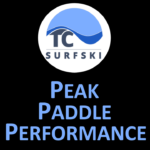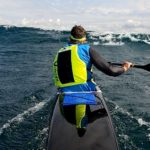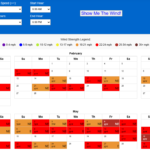Mixed Messages
As happens from time to time in the surfski world, there are some mixed messages around what paddlers should be striving for to improve their downwind paddling. In this blog I attempt to explain why seemingly opposing views are both correct, and most importantly distill it all into useful guidance for the average paddler.
Imagine a big spectrum, on one side the mantra is: stay calm, focus on minimal strokes and minimal effort, leverage the waves. On the other end of the spectrum the mantra is: you need power, fitness, and 110+ strokes per minute to be a proper downwind paddler. Both are accurate, the key is to understand the context
Focus Points for Beginner and Intermediate Paddlers
As a beginner the first priority is getting stable in your boat, mastering the brace, and developing the ability to put power into your stroke. Once you’re solid on these, the next phase is developing the timing and finesse to leverage the waves. This takes years to master, and the only way to progress is to slow down, increase your awareness, and experiment like crazy to find what works. The popular drill of counting strokes and trying to see how far you can go with minimal strokes is essential. This is the only way you will ever develop the necessary feel, finesse, and pattern recognition. The big improvements will come as you gain a better feel for when you are on the wave and can stop paddling (sooner than you think). As you work to maximize the length of time on the wave you will want to experiment with changing your angles and shifting your body weight to extend the ride without paddling.
Finding the Right Conditions is Key
One of the big challenges is that as a beginner or intermediate paddler, in order to work on all of the above, you need the right conditions. Here again, there is a huge spectrum of downwind conditions to contend with. The easiest surfing conditions are the best for learning. Clean waves at 1 1/2 to 3 feet, steady wind, and favorable currents all help to create those conditions. The ratio of wind strength to wave size is a major factor (high wind and small waves is good, low wind and big waves is hard). The stronger the wind relative to wave size (i.e. areas with limited fetch) the easier surfing conditions will be. Contrary to conventional wisdom, steeper, stacked waves are easier to surf (at least up to a point of around 5-6 feet where you can risk pitch poling the boat, but that is pretty rare).
Hood River and the Straits of Gibraltar are two of the best places I’ve experienced. I’ve also found that larger lakes or bays where you have 3+ miles of fetch can also create nice learning conditions. Additionally any location with a natural or man made point that allows the waves to wrap around it, will create fun, clean, and easy waves for learning to surf. For a more detailed explanation on surfing conditions check out this blog I wrote last year.
In bigger, messier, more complex, and faster moving conditions with wind waves and ocean swell, it will become exponentially harder for a beginner or intermediate paddler to practice all of the above. The best you can do in these conditions is try to stay hyper focused on seeking out the small waves and catching them. Connect enough and you may find yourself on a big run, but you will destroy yourself trying to force it. For more detail on what I mean by catching the easy waves, check out this blog on wave ranking based on the ease of catching it.
Downwind Racing at the Elite Level
The elite downwind paddlers will consistently record kilometer splits under 3:30 (equivalent of about 10.6 mph and above). I’m not there yet, but I’m determined to figure out what it takes. The realization I’ve had over the past few months is that while I can still make improvements in downwind skills, my fitness has now become a more limiting factor. In the typical conditions that I paddle in (2-4 foot waves, wind at 10-15 knots) I can average 8.5 to 9.5 mph with limited effort . But to push above that into the 10 mph range takes a different approach. My sense is that it becomes a game of “musical waves”. Rather than maximizing the ride on a given wave and then waiting for the next good opportunity, your mindset and approach shifts and you have to be aggressive and use each wave as a launching platform to the next. Here all the skills you learn by going slow with minimal strokes comes into play to help your timing and alignment for the next launch. But rather than relaxing and riding out the wave paddles down, you now catch the wave, take a brief breather, then go, for lack of a better term, bat shit ballistic, accelerating from 10.5 mph to 12.5 mph and onto the next run. The only way I’ve found to do this is with a cadence easily hitting 120 strokes per minute. When the boat is already moving at 10+ mph, I’m not sure it is possible any other way. Also keep in mind that the elite paddlers who operate at this level can average around 9 mph and a stroke rate of 110 single strokes per minute on a flat water 10k.
When racing you want to sustain the highest heart rate you physically can for the duration of the race. But you also want to leverage the waves, so the key is to focus all of your effort at the right time. This is exactly what the elite paddlers are doing by timing their launches off the wave they’re riding and onto the next. They are aggressively shooting gaps and jumping over waves whenever the opportunity presents. It is amazing what becomes possible when you can hold boat speeds well above the speed of the waves. In his most recent blog recapping the Maui to Molokai race, Austin Kieffer describes surging back and forth against Pat Dolan. This is an example of putting in a big max effort, accelerating the boat beyond the speed of the waves and thereby linking and/or jumping multiple waves at a time.
Assessing Downwind Proficiency
I suspect one of the biggest challenges most of us have, is that it isn’t easy to know whether your limiting factor is fitness or surfing skills and to what degree. Perhaps someday we’ll have a data model where you can input your 10k flat water time and your downwind splits in a given condition (i.e. wind strength/waves size/current). This could then provide a type of downwind proficiency rating. I’m sure the data exists, it would just be matter of building it. Anyone interested ? 🙂
Summary
In summary, no matter what level you’re at, there is always improvement to be made. The only way to make this improvement is by slowing down, studying the waves and patterns, and experimenting with different timing, direction, and body movements. That said, in certain conditions and at the elite level of racing, you also need to have incredible fitness and an ability to ramp up your cadence. Additionally you have to shift out of a mindset of milking the runs and into a mindset of using each wave as a catapult to the next. It becomes a game of musical waves and you can’t afford to get caught waiting.
If you found this post helpful, please feel free to share on your social media and don’t hesitate to contact me with further questions or suggestions!



